Top 5 Features of the APIO 24 inch Smart Pad You Didn’t Know About最先出现在Dynamics Blog。
]]>If you’ve only seen it as another display, think again. Below, we’ll uncover five powerful and often overlooked features that make the APIO 24 inch Smart Pad a must-have for professionals, students, gamers, and creatives alike.
1. A True All-in-One Touch Experience
Unlike traditional monitors that simply project visuals, the APIO 24 inch Smart Pad delivers a seamless multi-touch experience—turning your interaction from passive to dynamic. You can swipe, draw, zoom, and even annotate directly on the screen.
-
For designers: It works as a precision drawing tablet, offering natural pen pressure and responsive touch.
-
For presenters: You can highlight points and write notes in real-time during meetings.
-
For educators and students: It becomes an interactive whiteboard for lessons and online collaboration.
This level of interactivity transforms the Smart Pad into a powerful creative and productivity tool, not just a display.
2. Superior Display Technology: True Visual Brilliance
The APIO 24 inch Smart Pad is built around a high-definition, color-accurate display that brings visuals to life. Whether you’re editing photos, gaming, or streaming videos, the visual clarity and depth are exceptional.
Key Display Highlights
-
Resolution: Crisp detail perfect for media, spreadsheets, and design.
-
Color accuracy: Reproduces vibrant tones, ideal for content creators.
-
Eye-care technology: Reduced blue-light emission and flicker-free visuals for long working hours.
Imagine having the quality of a studio monitor combined with the flexibility of a portable touch device—that’s what makes this Smart Pad unique.
3. Multi-Device Connectivity and Compatibility
One of the most underrated yet impressive aspects of the APIO 24 inch Smart Pad is its universal compatibility. It’s engineered to connect effortlessly across a wide range of devices and systems.
Connects Seamlessly To:
-
Laptops & PCs (Windows, macOS, Linux)
-
Smartphones & tablets (Android and iOS)
-
Gaming consoles like PlayStation, Xbox, or Nintendo Switch
-
Smart home setups for display mirroring or streaming
This makes the Smart Pad a perfect hub for multitasking. You can write an email from your laptop while mirroring a mobile presentation—all on one elegant screen.
Pro Tip: If you’re a remote worker or digital nomad, pairing your Smart Pad with your laptop instantly creates a dual-display workspace without extra bulk.
4. AI-Enhanced Smart Functions
This is where the APIO 24 inch Smart Pad really lives up to its name: Smart. Beyond its hardware specs, it integrates AI-driven features that enhance usability and productivity.
Intelligent Capabilities Include:
-
Auto brightness and color adjustment based on ambient light.
-
Gesture recognition for switching apps or controlling presentations hands-free.
-
Smart task suggestions that adapt to your usage patterns over time.
-
Voice control integration with smart assistants for hands-free operation.
These built-in AI optimizations ensure the screen doesn’t just respond—it anticipates your needs.
For example, when you start sketching, it may automatically switch to drawing mode and optimize the pressure curve for smoother strokes. This type of intelligent interaction streamlines workflows and enhances the overall experience.
5. Designed for Hybrid Work and Modern Lifestyles
The APIO 24 inch Smart Pad is tailored to today’s hybrid lifestyle, where work, learning, and play happen everywhere—from office desks to cafés and living rooms.
Why It Fits Modern Life
-
Lightweight & portable design – Easy to carry between home and workspaces.
-
Flexible mounting options – Use it as a desktop display, wall mount, or portable workstation.
-
Built-in collaboration tools – Great for online meetings, digital classrooms, or family sharing.
This versatility makes it more than a piece of hardware—it’s an adaptable digital companion for every part of your day.
And if you’re constantly on the move, pairing it with cloud platforms like Google Drive or Microsoft OneDrive helps keep your files synchronized across all devices connected to the Smart Pad.
Bonus: Minimalist Aesthetic Meets Smart Engineering
It’s impossible not to mention the APIO 24 inch Smart Pad’s sleek and modern design. With ultra-thin bezels, a clean matte finish, and a minimalist stand, it blends into any workspace or home environment.
Its thoughtful engineering means you’re not only buying a display—you’re investing in a versatile productivity and entertainment center that enhances your workflow, creativity, and comfort.
Real-World Scenarios
To see how these features play out in daily life, imagine these use cases:
-
A designer on the go uses the Smart Pad to sketch concepts directly during client meetings.
-
A teacher transforms the screen into a live whiteboard for online classes.
-
A gamer connects their console to enjoy immersive gameplay on a vivid, responsive screen.
-
A corporate team uses it for brainstorming sessions, marking notes, and sharing visuals instantly.
Each scenario showcases how one device can serve multiple purposes effortlessly.
Why You Probably Haven’t Noticed These Features
Many users initially see the APIO 24 inch Smart Pad as “just another big tablet.” But its integration of AI, multi-device flexibility, and professional-grade display puts it in a completely different category.
Most conventional monitors can show your work. The Smart Pad helps you create it faster, see it clearer, and share it smarter.
Final Thoughts
The APIO 24 inch Smart Pad is not just a screen—it’s a statement of smart design and technological evolution. From AI-enhanced controls to universal connectivity and touch precision, it redefines what a large-format smart display can do.
Whether you’re an artist, gamer, teacher, or remote worker, these five hidden features make the Smart Pad an investment that adapts to your needs and grows with your lifestyle.
So next time you think of upgrading your setup, don’t just look for a bigger screen—look for a smarter one.
www.apiomate.com
APIO
Top 5 Features of the APIO 24 inch Smart Pad You Didn’t Know About最先出现在Dynamics Blog。
]]>Performance, Application Scenarios and Selection of External Panel Materials for Outdoor Mobile Shelters最先出现在Dynamics Blog。
]]>The mainstream external panel materials for shelters on the market include Fiberglass Reinforced Plastic (FRP), color-coated steel sheets, aluminum sheets, stainless steel sheets, and Carbon Fiber Reinforced Composite (CFRC). These materials differ significantly in material properties, performance parameters, and applicable scenarios. This article will analyze the core differences between various materials from a technical perspective, provide material selection suggestions combined with practical application cases, and assist industry practitioners and purchasers in making accurate decisions.
Color-Coated Steel Sheets (Colored Coated Steel Plates)
Core Characteristics: Taking cold-rolled steel sheets or galvanized steel sheets as the base material, the surface is sprayed with colored coatings (such as polyester, fluorocarbon, etc.), and is often made into composite sandwich panels (with polyurethane, rock wool, etc. as the core material).
· Advantages: Low cost (about 1/3 of aluminum sheets), excellent thermal insulation performance (the thermal conductivity coefficient of the sandwich structure is as low as 0.024W/(m·K)), integrated paint finish for long service life, convenient installation, and rich color options.
· Disadvantages: Average weather resistance, weak impact resistance.
· Key Differences: No prominent single feature, but the highest cost-effectiveness, suitable for most application scenarios.
· Typical Application Scenarios:
· Communication base stations, environmental monitoring stations, general shelters, temporary emergency shelters (temporary resettlement shelters for earthquake and flood rescue): Rapid deployment and low-cost mass production.
· Camping accommodation shelters: Good thermal insulation effect to meet living comfort and control operating costs.
· Temporary on-site office shelters: Meet short-term usage needs and reduce project investment.
Aluminum Sheets (Aluminum Alloy Sheets, Common Models: 5052/6061)
Core Characteristics: Taking aluminum alloy as the base material, processed through rolling, anodization or spraying, featuring light weight and balanced strength.
· Advantages: Lightweight (density 2.7g/cm³, only 1/3 of steel), rust resistance (oxide layer forms a protective film), easy processing (good bendability and weldability), and high recycling rate (up to 95%).
· Disadvantages: Relatively high cost, weak resistance to hard object impact (easy to dent), and strength degradation in high-temperature environments (>120℃).
· Key Differences: Balances lightweight and durability, making it the preferred choice for mobile shelters; compared with stainless steel sheets, it is lighter, suitable for scenarios with high mobility requirements.
· Typical Application Scenarios:
· Mobile medical shelters (nucleic acid testing shelters, emergency transfer shelters): Lightweight for vehicle transportation, easy surface disinfection, and no rust risk.
· Field exploration shelters (mobile laboratories for geological and oil exploration): Reduce transportation load and adapt to handling in complex road conditions.
Stainless Steel Sheets (Common Models: 304/316L)
Core Characteristics: Taking iron-chromium alloy as the base material with a chromium content of ≥10.5%, featuring strong corrosion resistance and hygiene.
· Advantages: Excellent weather resistance (stable in -40℃~80℃ environment), rust resistance (316L model can resist seawater corrosion), high strength (tensile strength ≥520MPa), and hygienic non-toxicity (meets food/medical grade standards).
· Disadvantages: Heavy weight (density 7.93g/cm³), high cost (304 model is about 4 times the cost of color-coated steel sheets), and high processing difficulty.
· Key Differences: Optimal hygiene and weather resistance, suitable for scenarios with extremely high requirements for cleanliness and safety; compared with aluminum sheets, it has higher strength but heavier weight.
· Typical Application Scenarios:
· Medical shelters (operating rooms, isolation cabins): No risk of bacterial growth, resistant to high-frequency disinfection (alcohol, chlorine-containing disinfectants).
· Explosion-proof shelters (gas stations, nuclear power plants, etc.).
· Food testing shelters (field food safety monitoring stations): Meet food-grade hygiene standards and resist pollution.
· Island/coastal operation shelters: 316L model can resist seawater and salt spray corrosion, with no rust during long-term use.
Fiberglass Reinforced Plastic (FRP)
Core Characteristics: Taking glass fiber as the reinforcing material and resin as the matrix, formed through compression molding process.
· Advantages: Lightweight and high strength (density 2.0-2.2g/cm³, specific strength close to steel), good surface sand resistance, strong corrosion resistance (resistant to acid, alkali, salt spray, and humidity), flexible molding (customizable complex curved surfaces), good insulation performance, and medium cost.
· Disadvantages: Easy to age in long-term high-temperature environments (>80℃), and difficult to recycle.
· Key Differences: Compared with metal panels, FRP has no electrochemical corrosion problem, suitable for extreme corrosion environments; compared with color-coated steel sheets, it has higher structural strength, no need for additional support frames, and good sand resistance, making it suitable for desert areas.
· Typical Application Scenarios:
· Marine operation shelters (offshore platform living cabins, fishery breeding shelters): Resist salt spray corrosion and can be immersed in high-humidity environments for a long time.
· Chemical emergency shelters: Resist acid and alkali waste liquid erosion and ensure equipment safety.
· Case: Our company customized an FRP shelter for a coastal oil exploration team. After 5 years of continuous use in an environment with a salt spray concentration of 0.05mg/cm², the surface showed no rust or cracking, and still maintained more than 85% of its structural strength.
Carbon Fiber Reinforced Composite (CFRC)
Core Characteristics: Taking carbon fiber as the reinforcing material and resin as the matrix, formed through compression molding or prepreg process, belonging to high-end composite materials.
· Advantages: Extremely lightweight (density 1.5-1.8g/cm³, 1/5 of steel), extremely high strength (tensile strength ≥3500MPa), excellent weather resistance (stable in -50℃~150℃ environment), good shock absorption, and strong appearance texture.
· Disadvantages: High cost (about 8-10 times the cost of FRP), high maintenance difficulty (professional repair required after damage), and high brittleness (weaker impact resistance than metal).
· Key Differences: Represents the top-tier performance, suitable for high-end scenarios with extreme requirements for weight, strength, and appearance; compared with other materials, cost is the biggest barrier.
· Typical Application Scenarios:
· Military shelters (radar shelters, command shelters): Lightweight enhances mobility, and high strength resists harsh battlefield environments.
· High-end accommodation shelters (luxury camping cabins, custom private mobile villas): Balance appearance and performance to create a high-end experience.
· Scientific research shelters (polar scientific research shelters, aerospace ground support shelters): Adapt to extreme temperature differences and reduce transportation load.
|
material |
density(g/cm³) |
tensile strength(Mpa) |
weather resistance |
Cost level |
Core strengths |
Applicable scenarios |
|
· Fiberglass Reinforced Plastic(FRP) |
· 2.0-2.2 |
· 200-350 |
· Excellent |
· moderate |
· Corrosion resistant, lightweight and high-strength, flexible molding |
· Ocean, chemical, extreme corrosion |
|
· Color-Coated Steel Sheets |
· 7.8 |
· 300-400 |
· moderate |
· low |
· Insulation, low cost, easy to install |
· Temporary emergency, camping, base station, environmental monitoring |
|
· Aluminum Sheets |
· 2.7 |
· 200-300 |
· Excellent |
· intermediate to advanced |
· Lightweight, rust proof, easy to process |
· Mobile healthcare, field exploration, strong mobility |
|
· Stainless Steel Sheets |
· 7.93 |
· 520-680 |
· Extremely Excellent |
· · advanced |
· Corrosion resistant, hygienic, and high-strength |
· Medical, food, coastal, high cleanliness |
|
· Carbon Fiber Reinforced Composite |
· 1.5-1.8 |
· ≥3500 |
· Extremely Excellent |
· Extremely advanced |
· Ultimate lightweight, ultra-high strength |
· Military industry, high-end tourism, and extreme research environments |
Material Selection Guide: 3-Step Process to Select Suitable Panels
· Clarify Core Requirements: Prioritize key indicators first — whether it is "cost priority" (choose color-coated steel sheets), "lightweight priority" (choose aluminum sheets/carbon fiber), "corrosion resistance priority" (choose FRP/stainless steel sheets), or "strength priority" (choose stainless steel sheets);
· Match Usage Environment:
· Extreme corrosion (marine/chemical industry) → FRP/316L stainless steel;
· Low/high temperature (polar/desert areas) → carbon fiber/stainless steel;
· Humid and rainy conditions → aluminum sheets/FRP;
· Company Strength: Customized Design, Production, and Supply of Integrated Shelter Solutions
· Jinhua Zhongxing Communication Technology Co., Ltd. is a professional enterprise engaged in the R&D, development, production, and installation of outdoor equipment rooms/cabinets/shelters, emergency communication equipment, communication towers, and other outdoor supporting facilities for communication base stations, as well as for environmental monitoring, smart transportation, data applications, power energy storage, and climate monitoring stations.
www.jhzxctech.com
Wenzhou FunFort Bear Amusement Equipment Co., Ltd.
Performance, Application Scenarios and Selection of External Panel Materials for Outdoor Mobile Shelters最先出现在Dynamics Blog。
]]>MiniPC is a feature of CES 2025. Can it beat the Mac mini最先出现在Dynamics Blog。
]]>Not the iPhone 16 series, not the Apple Watch with a higher screen ratio, not even the iPad or MacBook that came out without any changes, and not even the Vision Pro, which is expected to be the coolest product in Apple's history.
Apple's most successful product last year was the Mac mini, which quietly went on sale on October 29.
Why? The reason is simple: it's small, stylish, all-in-one, quiet, cheap, and decent. Apple hasn't had a simple, easy-to-use product in a long time, so it's no wonder it's going viral on social media.
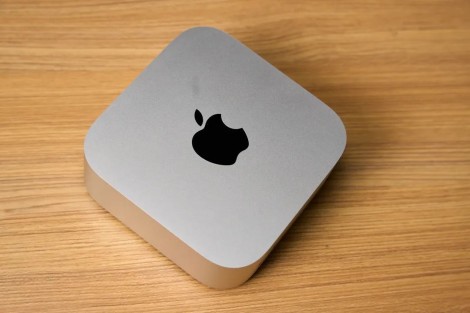
I don't know if it has anything to do with this sudden "Mac mini boom," but CES 2025, one of the most anticipated electronics shows for digital product lovers and the largest and most influential consumer electronics technology annual show in the world, did see more miniPCs.
As in previous years, in order to bring you the freshest first-hand reports, Leitech sent a field reporting team led by senior editors "Yi Yitianming" and "Dingxi" to Las Vegas, Nevada, USA, to observe and experience these new things at the venue.
And today's topic is the return trend of desktop miniPC.
MiniPC dominates CES: Smaller, more powerful
In the past, I think more than half of people's perception of miniPC was based on NUC.
As Intel's main push for miniPC business, NUC series once tried to compete with Apple's Mac mini in the market by virtue of richer hardware configuration choices and higher scalability, but it was eventually abandoned by Intel due to its poor management of its own core business.
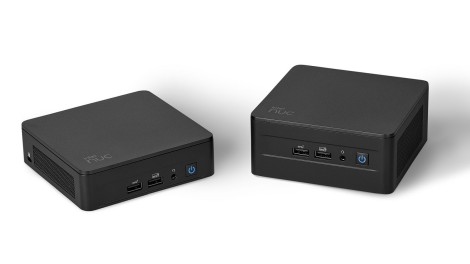
No one expected the miniPC market to be slowly picking up a year and a half after Intel announced it was abandoning the NUC.
Lenovo unveiled the new ThinkCentre neo 50q QC at CES 2025. The product is thinner, smaller and more sophisticated than previous ThinkCentre neo series, and even more powerful in performance. It has 45 TOPS dedicated AI computing power, designed for multitasking and efficient data processing.

The huge increase comes mainly from changes in the processor. The 1L miniPC is available with Qualcomm Snapdragon X and Snapdragon X Plus processors, up to 16GB of LPDDR5x memory +2TB storage, and supports the latest Copilot+ PC features and advanced AI features.
According to Lenovo, this is the world's first AI miniPC powered by Snapdragon.
Since there are those who have changed direction, there will naturally be those who are conservative. Established manufacturers Asustek and MSI have still taken over the product name "NUC" and are determined to continue the brand.
At CES 2025, ASUS introduced the ROG NUC (2025), which is an undeniably powerful beast with an Intel Core Ultra 200HX processor and the latest RTX 5080 laptop graphics card in its narrow body.

In the niche field of miniPC, maybe only ROG has the courage to make products at this level.
As for MSI, it is more focused on the "compact" nature of its products. The Cubi NUC AI+ 2M, which was released at CES 2025, is only 0.826L in size, with the highest optional Core Ultra 7 258V processor, up to 32GB LPDDR5x memory, and even a physical Copilot button.
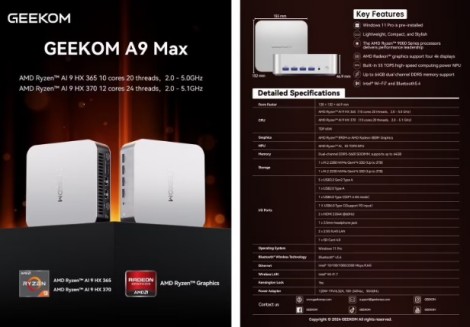
What? Not into Intel?
Of course, there are also AMD processors. Chinese manufacturer Jiukore launched three new miniPC products at CES 2025, among which the new Jiukore A9 Max is equipped with the latest AMD Ryzen AI 9 HX processor. There are three versions available: 365,370 and 375. The top configuration product has the theoretically strongest core display performance at present.
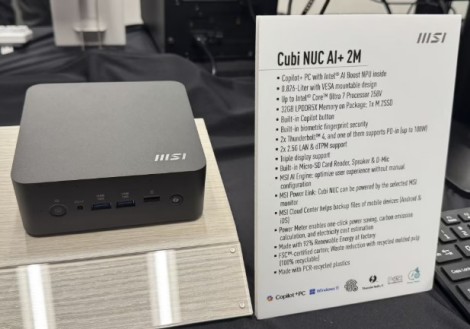
Some manufacturers are even thinking of combining miniPCs with other categories.
A prime example is the N5 Pro showcased by Chinese manufacturer Mingfan at CES 2025. The device features a standalone miniPC module in its lower half, while the upper section boasts five dedicated 2.5/3.5mm hard drive slots. Powered by AMD's Ryzen AI 9 HX PRO 370 processor, this compact system supports up to 96GB of ECC memory.
For an industry that still uses N100 processors, this is a bit of a wild thing.
MiniPC to break through by differentiation?
You may wonder, why did the miniPC market improve after NUC was abandoned?
Well, these two things are not necessarily related.
In my opinion, this wave of miniPC boom is more closely related to the development trend of AI PC category in the past two years.
Over the past year, large language model technology has seen rapid development. Model-powered intelligent agents have become an indispensable component in consumer electronics. Unlike smartphones that primarily rely on cloud-based large models, more powerful PCs can now support on-device AI models, enabling local generative AI applications. Notably, AI PC shipments alone surpassed 40 million units in the past year.
In order to compete for the commanding heights of AI PC, major manufacturers are racing in technology research and development, marketing and user experience optimization, hoping to break through by differentiation.
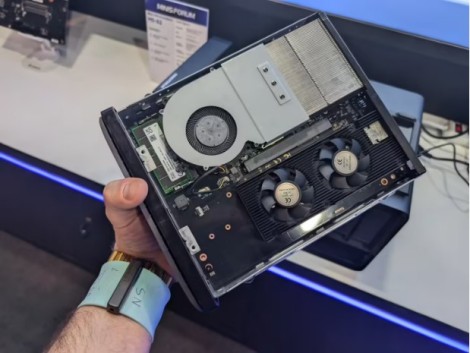
And miniPC is part of the differentiation strategy.
Compared to traditional PC/ITX systems designed for fixed environments, mini PCs offer compact dimensions, space-saving features, and exceptional portability, making them ideal for small offices or residential spaces. When compared to laptops that also cater to mobile use cases, mini PCs typically support multiple connectivity options, providing greater flexibility. They also demonstrate superior advantages in external interface expansion and internal configuration upgradability.
As Lenovo says, the miniPC is likely to become a simplified local AI terminal that small and medium-sized companies will have to use in the future.
And what underpins the ambitions of various manufacturers is the PC supply chain, which is currently in rapid development.
In the middle of last year, Qualcomm and a number of PC manufacturers launched several PC products with snapdragon X series processors, and gained a new compatible layer of Windows on ARM, which did break Apple's long-term monopoly on high energy efficiency ratio for Mac, bringing considerable battery life and AI performance to Windows users.
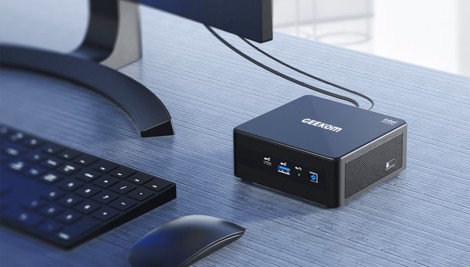
By the end of the year, Intel's Core Ultra 200V series processors achieved remarkable energy efficiency on the x86 platform. At CES 2025, Intel unveiled its second-generation Core Ultra processors for AI PCs, including the 200V,200HX, 200H, and 200U models. Meanwhile, AMD unveiled its Ryzon AI Max, AI 300, and 200 series processors, all providing new capabilities for AI-powered PCs.
On the graphics side, Nvidia's RTX 50 series laptop graphics card, which will be presented at CES 2025, is expected to deliver twice as much AI performance per watt as its predecessor.
The top support of the supply chain has also given the PC industry a "second spring".
Can a miniPC flip a Mac mini?
Of course, some readers may ask at this point.
Looking at your analysis here, can these new miniPCs really beat the unrivaled Mac mini?
Well, there are advantages to that.
No matter how much Apple fans like to emphasize the usability of Mac, it cannot change the fact that Windows is the most widely used system in the world at present. With the support of these terminal-side AI chips, miniPC is expected to provide users with a better office experience through AI applications such as personal intelligence agents, and win the recognition of users.
The same principle applies to performance. While the M4 processor's improvement over the M1 can only be described as a reasonable performance boost from minor manufacturing process optimizations, the PC-side AI chips released in recent years have achieved revolutionary advancements compared to previous generations. The ROG NUC (2025) equipped with an RTX 5080 laptop GPU even rivals top-tier gaming PCs in performance.
As for the disadvantage, I think it is mainly in the Internet ecology.
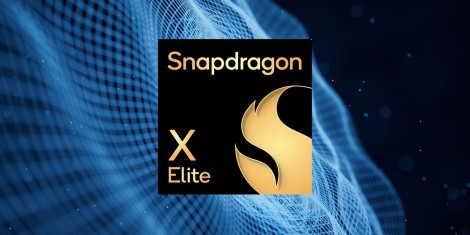
In addition to Lenovo, most PC manufacturers are not doing a good job of coordinating between mobile phones, tablets and PCs. Even though Microsoft and Intel have launched their own cross-screen collaboration solutions, there is obviously a gap in the experience compared with Apple's Internet ecosystem which has been deeply cultivated for many years.
You may not believe it, but the ability to break down the same work across multiple devices is one of the reasons many people are willing to buy a Mac mini.
Another reason they're willing to buy the Mac mini is its "affordability". While priced at nearly 3,600 yuan, it doesn't offer much of a competitive edge against mini PCs. Yet the Mac mini has become a hot item that sells out quickly, even spurring production among accessory manufacturers. This clearly shows people can't resist the allure of an affordable Apple product.
It is not realistic for PC manufacturers to try to lure away users who pay for "scarcity experiences".
On January 7, 2025, CES (International Consumer Electronics Show) 2025 grandly opened as the most popular edition in history, marking a watershed moment for the tech world's transition from mobile to AI. The Lei Tech reporting team is on the ground in Las Vegas, USA, providing intensive live coverage of CES. Follow/search Lei Tech for first-hand content covering new product launches, industry insights, technical analyses, product experiences, and exclusive interviews from the front lines.
www.sz-risingsun.com
Shenzhen Rising Sun Electronic Technology Co., Ltd.
MiniPC is a feature of CES 2025. Can it beat the Mac mini最先出现在Dynamics Blog。
]]>Why Micro Gimbal Camera Technology Is Changing the Way You See the World最先出现在Dynamics Blog。
]]>What a Micro Gimbal Camera Is
A Micro Gimbal Camera is a small camera with a built-in gimbal. The gimbal is a set of motors and sensors. It keeps the camera steady. When the platform moves — a drone, robot, or vehicle — the gimbal corrects motion. The result is less blur and smoother video.
These small systems can hold high-quality imaging sensors. That means you get good pictures without heavy or bulky gear. You can mount a Micro Gimbal Camera where larger cameras cannot fit.
Key Benefits at a Glance
A Micro Gimbal Camera brings several clear benefits:
-
Stable images: The gimbal reduces shake and vibration.
-
Lightweight: It keeps the total weight low.
-
Easy to install: Many models are plug-and-play.
-
Versatile: Works on drones, robots, and handheld devices.
-
Cost effective: Small size often means lower power use and lower costs.
These benefits help you get better data, fast. When images are stable, analysis is easier. Teams save time. Decisions become clearer.
How the Technology Works
A Micro Gimbal Camera uses motors and sensors to sense motion. When movement happens, the gimbal moves the camera in the opposite direction. It does this very fast — many times per second.
Modern models add smart control software. The system may include:
-
Gyroscopes and accelerometers to sense motion.
-
Brushless motors for smooth movement.
-
A controller that runs stabilization algorithms.
-
Software for tracking or auto-follow features.
Some Micro Gimbal Camera units also support thermal or multi-sensor modules. That means you can capture IR (infrared) data along with visible light. This makes the camera useful for inspections in low light or for detecting heat signatures.
Where Micro Gimbal Cameras Are Used
These small gimbal cameras are now common in many fields:
-
Aerial inspection — Drones use a Micro Gimbal Camera to inspect roofs, towers, and bridges. The steady view helps inspectors find cracks and faults.
-
Security and surveillance — Fixed or mobile systems with a Micro Gimbal Camera improve area monitoring. The stabilized image lets people spot threats faster.
-
Robotics — Robots use these cameras to navigate and inspect tight spaces.
-
Search and rescue — In rescue operations, a Micro Gimbal Camera gives clear video from the air or ground, helping teams find people faster.
-
Media and film — Small gimbals make smooth shots for live video, news, and documentaries.
Design Choices That Matter
When you pick a Micro Gimbal Camera, some design points matter more than others:
-
Payload weight: How much camera weight can the gimbal carry?
-
Axis count: 2-axis or 3-axis stabilization affects smoothness.
-
Sensor support: Can it host thermal or EO sensors?
-
Power draw: Lower power means longer battery life for drones.
-
Control options: Does it support remote control or auto-tracking?
-
Environment rating: Is it dustproof, splashproof, or designed for harsh weather?
Choosing the right mix helps you get the most from a Micro Gimbal Camera in your projects.
Integration and Customization
Many teams need custom gear. A Micro Gimbal Camera can be tailored to specific needs. You may want a custom housing, special connectors, or custom software. That is where OEM and ODM services come in.
If you need a branded product or a special build, working with a manufacturer that offers OEM/ODM makes the process easier. They can adapt the Micro Gimbal Camera to your size, sensor type, and control system.
Picking a Supplier: What to Look For
Not every vendor offers the same quality. When you evaluate suppliers for a Micro Gimbal Camera, check these items:
-
R&D strength: Do they design and test their own systems?
-
Production capacity: Can they meet your volume needs?
-
After-sales support: Will they help with integration and maintenance?
-
Quality control: Do they have testing for vibration, temperature, and shock?
-
Customization services: Can they do OEM/ODM work?
A supplier that scores well on these points can save you time and risk.
Why Kimbal Is a Strong Choice
For businesses looking for trusted partners, Kimbal is a name to consider. Kimbal focuses on Micro Gimbal Camera solutions and offers a full range of services.
What Kimbal offers:
-
Advanced stabilization systems in their Micro Gimbal Camera line.
-
Support for high-resolution imaging sensors and thermal modules.
-
Intelligent control features such as auto-tracking and motion correction.
-
OEM and ODM services to create custom housings, software, or branded units.
-
Quality control and testing suited to industrial needs.
If you need a supplier that provides both product and service, Kimbal can be a good fit. They aim to help companies integrate Micro Gimbal Camera systems into real projects, with steady supply and technical support.
Real-World Case Examples
To see the impact, here are short examples of how a Micro Gimbal Camera helps in the field:
-
Power Line Inspection — A drone flies along a line with a Micro Gimbal Camera. The steady footage shows worn parts and hotspots that require repair.
-
Factory Monitoring — A robot equipped with a Micro Gimbal Camera inspects machinery. Clear images let engineers catch faults early.
-
Coastal Patrol — A small gimbal camera on a drone spots a vessel with signs of trouble. The rescue team moves in faster.
These examples show how a Micro Gimbal Camera can turn raw images into useful action.
Cost and Return on Investment
You may worry about cost. A Micro Gimbal Camera often adds value quickly:
-
Fewer repeat inspections.
-
Faster decision making.
-
Lower risk of missed faults.
-
Better data for reports.
In many projects, the Micro Gimbal Camera pays back its cost by saving time and preventing errors.
Future Trends to Watch
The Micro Gimbal Camera field keeps changing. Watch for these trends:
-
Smaller and lighter designs with better sensors.
-
More AI features for auto-detection and tracking.
-
Multi-sensor fusion, putting visible and thermal data together.
-
Lower power use for longer drone flight times.
-
Greater customization through OEM and ODM partnerships.
As the tech improves, the Micro Gimbal Camera will become even more useful across industries.
Practical Tips for Deployment
If you plan to use a Micro Gimbal Camera, try these tips:
-
Test in real conditions before full deployment.
-
Check the gimbal’s vibration and shock ratings.
-
Match the camera sensor to your mission (thermal, EO, or both).
-
Ensure the control interface fits your existing system.
-
Ask the supplier about firmware updates and support.
Good preparation makes integration easier and boosts system uptime.
Final Words: Making the Right Choice
A Micro Gimbal Camera can make your vision systems clearer and your work more effective. It helps you collect better data and make better decisions. When choosing a model and a partner, focus on stability, sensor options, supplier strength, and after-sales support.
If you need a dependable partner for Micro Gimbal Camera solutions, consider Kimbal. They offer product expertise, OEM/ODM flexibility, and tested systems to help you meet your project goals.
The world keeps moving. With a Micro Gimbal Camera, your view can stay steady.
https://whjbkj-002.us.aitsite.cn/Micro-Gimbal-Camera
Kimbal
Why Micro Gimbal Camera Technology Is Changing the Way You See the World最先出现在Dynamics Blog。
]]>Why GNSS Modules Are Essential for Modern Surveying and Industrial Projects最先出现在Dynamics Blog。
]]>What is a GNSS Module
A GNSS module is an electronic device that receives signals from global navigation satellite systems such as GPS, BeiDou, GLONASS, and Galileo. It calculates precise positioning, velocity, and timing information for a wide range of applications.
Modern GNSS modules support multiple constellations simultaneously, enhancing positioning accuracy and reliability. By integrating GNSS modules into drones, surveying instruments, or industrial machinery, operators can achieve centimeter-level precision, which is critical for high-stakes projects such as infrastructure construction, agricultural planning, and mining operations.
Key Advantages of GNSS Modules
GNSS modules provide numerous benefits across industries:
-
High Precision: Advanced multi-constellation GNSS receivers ensure centimeter-level accuracy.
-
Reliability: Multi-system support reduces signal loss in challenging environments.
-
Real-Time Data: Supports RTK (Real-Time Kinematic) and PPK (Post-Processing Kinematic) corrections for immediate actionable insights.
-
Versatility: Compatible with UAVs, construction machinery, industrial robots, and survey instruments.
Integrating GNSS modules allows businesses to automate operations, reduce errors caused by manual measurements, and enhance decision-making based on real-time geospatial data.
Applications Across Industries
Surveying and Construction
GNSS modules are extensively used in surveying, mapping, and construction. High-rise buildings, bridges, and tunnels require precise positioning during both planning and execution phases. With real-time GNSS modules, engineers can monitor structural shifts, track machinery positions, and ensure that all construction activities are aligned with design specifications.
UAV and Drone Applications
UAVs equipped with GNSS modules provide high-precision aerial surveys. These drones capture topographic data, 3D models, and photogrammetry outputs quickly and efficiently. Real-time GNSS corrections, including RTK and CORS networks, ensure positional accuracy, which is critical for applications like agriculture mapping, infrastructure inspection, and environmental monitoring.
Agriculture and Precision Farming
In modern agriculture, GNSS modules support precision farming techniques. Tractors, planters, and harvesters equipped with GNSS modules can navigate fields with centimeter-level accuracy. This precision reduces overlap, optimizes seed and fertilizer use, and increases crop yields while minimizing environmental impact.
Mining and Industrial Operations
GNSS modules are used for equipment tracking, slope monitoring, and volumetric measurements in mining sites. Real-time positioning helps ensure operational safety, resource optimization, and regulatory compliance. Combining GNSS modules with industrial automation systems enables remote monitoring and predictive maintenance.
Transportation and Fleet Management
Fleet operators leverage GNSS modules to track vehicles in real-time, optimize routes, and enhance logistics efficiency. Accurate GNSS positioning reduces fuel consumption, improves delivery times, and provides safety alerts for vehicle operators.
Kepler Luojia Navigation Co., Ltd.: GNSS Module Solutions
Kepler Luojia Navigation Co., Ltd. provides high-precision GNSS modules for diverse industrial, surveying, and UAV applications. Their products are designed for reliability, accuracy, and seamless integration with various platforms.
Key Advantages:
-
Advanced Technology: Multi-constellation GNSS modules supporting GPS, BeiDou, GLONASS, and Galileo.
-
High Accuracy: RTK and PPK functionality ensures centimeter-level positioning.
-
Flexible Deployment: Compatible with drones, construction machinery, survey instruments, and industrial equipment.
-
Global Service Network: Technical support and logistics solutions for worldwide projects.
Kepler Luojia GNSS modules empower engineers, surveyors, and operators to achieve precise measurements, streamline workflows, and enhance operational safety.
Enhancing Accuracy with RTK and CORS Networks
GNSS modules integrated with RTK or CORS networks deliver high-precision real-time data. RTK-enabled GNSS modules communicate with base stations to correct positional errors, achieving centimeter-level accuracy even in challenging urban or mountainous areas.
For large infrastructure projects, UAV surveys, and precision agriculture, combining GNSS modules with RTK or CORS ensures data reliability. This allows project managers to monitor progress, detect deviations, and optimize resource allocation effectively.
Integration with Drones and UAVs
Drones equipped with GNSS modules revolutionize surveying and mapping workflows. UAVs can capture high-resolution images, topographic data, and 3D models with accuracy levels comparable to traditional ground surveys.
GNSS modules enable UAVs to navigate complex flight paths precisely, even under environmental constraints such as wind, trees, or buildings. Data collected by drones equipped with GNSS modules can be used for construction planning, environmental monitoring, agricultural assessments, and infrastructure inspections.
Case Studies: Infrastructure and Agriculture
Infrastructure Monitoring: GNSS modules on construction sites allow engineers to measure foundation shifts, structural alignment, and machinery positions. Projects like bridges and high-rise buildings benefit from continuous real-time monitoring, reducing construction errors and ensuring safety compliance.
Precision Agriculture: Farmers using GNSS modules in tractors, planters, and drones achieve precise field navigation. This reduces input waste, increases efficiency, and supports sustainable farming practices.
These case studies demonstrate how GNSS modules improve project efficiency, safety, and operational decision-making across industries.
Future Trends in GNSS Modules
The demand for multi-constellation, high-precision GNSS modules continues to grow as industries embrace automation, UAV applications, and smart infrastructure. Future developments will focus on:
-
Enhanced multi-frequency GNSS modules for better reliability in urban environments.
-
AI-assisted GNSS data processing for predictive analysis.
-
Greater integration with UAVs, robotics, and IoT networks for real-time automation.
Kepler Luojia Navigation Co., Ltd. is at the forefront of these innovations, delivering cutting-edge GNSS modules designed for tomorrow’s projects.
Final Thoughts: Contact Kepler Luojia Navigation Co., Ltd.
For projects where accuracy, efficiency, and reliability are paramount, GNSS modules are indispensable. Kepler Luojia Navigation Co., Ltd. provides advanced GNSS solutions for surveying, construction, UAV applications, precision agriculture, and industrial operations.
Contact Kepler Luojia Navigation Co., Ltd. today to explore their GNSS modules and discover how they can optimize positioning, enhance data accuracy, and improve operational workflows.
https://www.keplergnss.com/GNSS-Antenna
Kepler
Why GNSS Modules Are Essential for Modern Surveying and Industrial Projects最先出现在Dynamics Blog。
]]>Why a Leisure Cycling Helmet Matters: Key Differences from Road, Racing, Mountain, and Commuter Helmets最先出现在Dynamics Blog。
]]>A Leisure Cycling Helmet is designed for riders who prioritize comfort, everyday usability, and relaxed cycling experiences. Unlike helmets built specifically for racing, mountain riding, or high-speed road cycling, a leisure helmet focuses on practicality rather than extreme performance. This unique balance of protection, comfort, and casual styling makes it an ideal choice for urban riders, weekend cyclists, and anyone who values simplicity and ease of use.
As a professional helmet manufacturer, Dongguan Shouchuang Sports Goods Co., Ltd. offers leisure cycling helmets that match real-world riding habits—combining reliable protection with comfort-oriented design.
How a Leisure Cycling Helmet Differs From Other Helmet Categories
1. Design Philosophy: Comfort vs. Performance
-
Leisure Helmet:
Designed for relaxed riding conditions. The focus is on comfort, wide applicability, and simple styling suitable for daily wear. -
Racing / Road Helmet:
Built for high-speed efficiency, emphasizing aerodynamics, aggressive shapes, and minimal weight. -
Mountain Helmet:
Features extended rear coverage, rugged design, and enhanced protection against off-road impacts. -
Commuter Helmet:
Practical for daily use but often heavier and more feature-focused (lights, visors, reflective elements) compared to pure leisure helmets.
Why Leisure Makes Sense:
Most riders do not need race-level wind-tunnel designs or off-road protection. A leisure helmet is optimized around realistic daily riding rather than extreme scenarios.
2. Safety Requirements: Reliable Yet Not Over-Engineered
Leisure cycling helmets meet standard safety certifications and provide solid impact protection appropriate for low to moderate speeds.
Compared with other categories:
-
Racing helmets may feature advanced MIPS systems, multi-density foams, and professional-grade crash ratings.
-
Mountain helmets use thick shells and extended coverage designed for unpredictable terrain.
For leisure riders, these extreme protective layers can be unnecessary and add extra weight or bulk. A leisure helmet delivers the right level of safety without compromising comfort.
3. Ventilation & Cooling: Balanced for Casual Riding
-
Leisure Helmets:
Moderate ventilation that feels comfortable during light to medium cycling. The airflow is designed to cool without exposing the rider to excessive wind. -
Road / Performance Helmets:
Highly aerodynamic channels, dozens of vents, and aggressive cooling intended for intense physical effort. -
Mountain Helmets:
Large vents but with protective structures for debris and branches.
Why Leisure Doesn’t Need Extreme Ventilation:
Casual riding rarely reaches the intensity where maximum airflow is needed. Balanced ventilation keeps comfort high without complexity or cost.
4. Weight Differences: Light Enough, but Not Ultra-Light
-
Leisure helmets are comfortable and lightweight, but not competition-level light.
-
Race helmets are engineered with ultralight materials, sometimes at the cost of price and durability.
-
Mountain helmets tend to be heavier due to increased coverage.
For everyday cyclists, shaving off 30–50 grams offers minimal real-world benefit. Comfort and fit matter far more.
5. Style & Aesthetics: Designed for Daily Wear
Leisure cycling helmets prioritize:
-
Clean, simple shapes
-
Versatile styling
-
Colors that match casual clothing
-
A friendly, non-aggressive appearance
Road and mountain helmets often look sporty or technical—great for athletes but not ideal for casual city riding. A leisure helmet looks natural whether the rider is in jeans, summer wear, or commuting clothing.
6. Feature Requirements: Practical but Not Complicated
Leisure helmets emphasize:
-
Easy adjustments
-
Comfortable padding
-
Everyday durability
-
User-friendly buckles and straps
Meanwhile:
-
Racing helmets may include advanced aerodynamic features or goggle compatibility.
-
Mountain helmets may incorporate visors, chin guards, or MIPS systems.
-
Commuter helmets may include integrated lights or reflective systems.
These specialized functions are unnecessary for relaxed riding and would only add cost and weight.
7. Why Leisure Helmets Are a Meaningful Category
Creating a separate category for leisure cycling helmets is valuable because:
-
Most global cyclists are casual riders, not competitors.
-
Their needs differ significantly from athletes or mountain riders.
-
Comfort, versatility, and ease of use matter more than extreme performance.
-
A dedicated leisure helmet ensures a better experience for everyday cyclists.
A leisure helmet is the most realistic, cost-effective, and user-friendly option for the majority of riders.
A Leisure Cycling Helmet delivers exactly what casual cyclists need: comfort, essential protection, everyday style, and simple practicality. It differs clearly from racing, road, mountain, and commuter helmets by prioritizing usability over professional-level performance.
With years of manufacturing expertise, Dongguan Shouchuang Sports Goods Co., Ltd. produces leisure helmets that balance safety, comfort, and everyday convenience—perfect for relaxed riders who want reliable protection without unnecessary complexity.
https://www.helmetmanufacture.com/why-a-leisure-cycling-helmet-matters.html
Dongguan Shouchuang Sports Goods Co., Ltd.
Why a Leisure Cycling Helmet Matters: Key Differences from Road, Racing, Mountain, and Commuter Helmets最先出现在Dynamics Blog。
]]>Moisture can wreak havoc on LCD screens! Keep your display in a dry environment to prevent moisture buildup inside. For users in humid areas (especially in southern regions with high humidity), place desiccant around the screen to maintain dry air. If moisture does enter the screen, don't panic – simply move it to a warm spot like under a desk lamp to allow gradual evaporation, or contact the manufacturer for professional drying services.
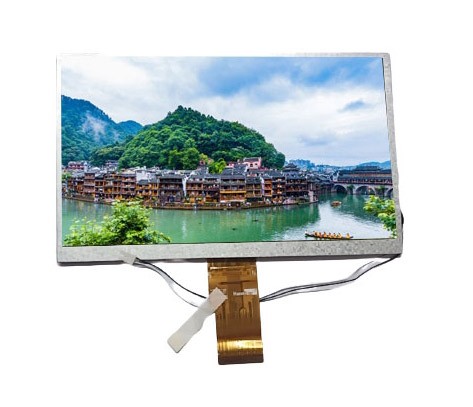
LCD displays have a complex structure. If the display malfunctions, never attempt to disassemble or modify it. Even after prolonged inactivity, the CFL (Cold Light Tube) converter in the backlight assembly may still carry approximately 1000V high voltage, which poses serious health risks. Attempting DIY repairs could render the display inoperable temporarily or permanently. Therefore, the safest approach is to seek professional repair services when issues arise.
LCD screens are soft (of course, except with protective cases) and easy to break. So when you use them, be careful not to hit the screen with a hard object, because hitting an LCD screen can cause irreparable damage.
During vigorous movements or vibrations, the internal liquid crystal molecules in the display may be damaged, significantly compromising its visual performance. Additionally, extreme impacts and vibrations should be avoided. LCD screens contain numerous glass components and sensitive electrical parts. Drops onto floors or similar violent impacts can cause screen or component damage. This requires special attention during transportation, with protective measures being implemented before handling.
LCD maintenance is very important, master some knowledge of LCD maintenance, LCD generally does not fail during its service life.
www.sz-risingsun.com
Shenzhen Rising Sun Electronic Technology Co., Ltd.
Municipal CPPCC Delegation Visits Company to Boost Innovation and Advance Kitchen Appliance Industrial Cooperation最先出现在Dynamics Blog。
]]>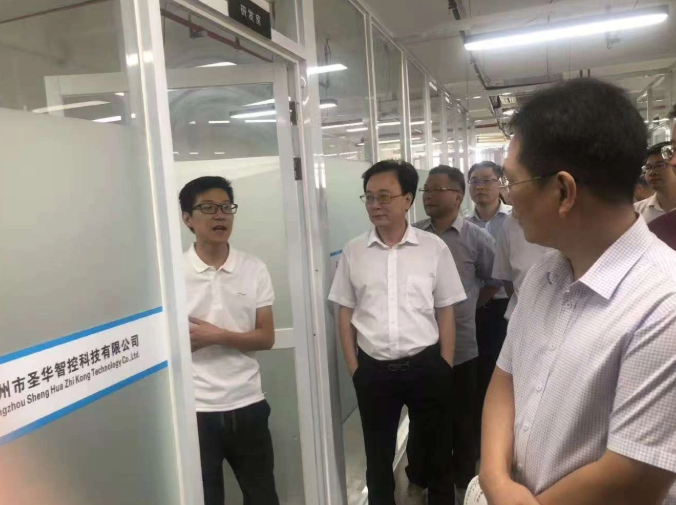

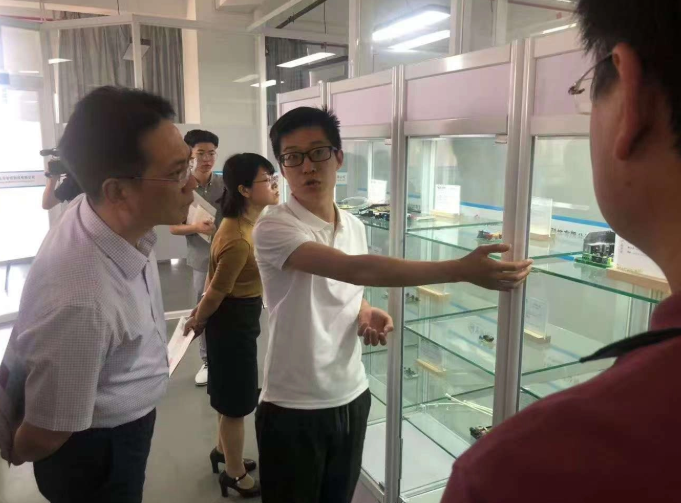
Recently, the chairperson of the Municipal Committee of the Chinese People's Political Consultative Conference led a delegation to visit and conduct research at our company. They aimed to gain a comprehensive understanding of the company's innovation and development as well as its industrial cooperation. Relevant leaders and department heads from the Municipal Committee of the Chinese People's Political Consultative Conference accompanied the visit. The company's general manager received them throughout the process and provided a detailed report on the company's.
During the discussion and on-site inspection, the general manager focused on introducing the core layout of the company's new research projects to the inspection team. Focusing on the upgrading needs of the kitchen appliance industry, the new projects are concentrated on three product directions: intelligent cooking equipment, green and energy-saving kitchen appliance accessories, and kitchen appliance digital control systems. Currently, multiple key technology breakthroughs have been completed, and some prototype products have entered the performance debugging stage. It is expected that after production, they will further enrich the local kitchen appliance product supply system. At the same time, the general manager also reported the cooperation achievements of the company with several well-known kitchen appliance enterprises in the city. Both parties have formed a stable cooperation mechanism in core component supply, joint research, and industrial chain support. The cooperation output value increased by 11% last year, achieving resource complementarity and coordinated development.
During the inspection, the chairperson highly praised the company's innovative vitality and its commitment to the industry. He pointed out that the company, based on the local kitchen appliance industry foundation, uses innovation-driven research to upgrade products, while deeply engaging in local cooperation and improving the synergy of the industrial chain, thereby injecting strong impetus into the high-quality development of the regional industry. He emphasized that the political consultative organization will fully play its role as a bridge and link, actively building communication and connection platforms for enterprises, helping to solve practical needs in development, continuously optimizing the business environment, supporting enterprises to grow larger and stronger, and promoting the clustered development of the kitchen appliance industry.
The general manager of the company stated that this inspection was a great encouragement for the development of the enterprise. In the future, the company will continue to increase its investment in research and development, accelerate the transformation of new project outcomes, deepen the cooperation level with local kitchen appliance enterprises, and contribute more to promoting the upgrading of regional industries.
www.shengfangkj.com
Shengzhou Shengfang Electrical Technology Co., Ltd.
Municipal CPPCC Delegation Visits Company to Boost Innovation and Advance Kitchen Appliance Industrial Cooperation最先出现在Dynamics Blog。
]]>Travel Light: Carrying the Smart Mobile Screen as Your Second Display最先出现在Dynamics Blog。
]]>In the era of remote work and digital freedom, screen space is productivity. A single laptop screen often feels limiting—whether you’re multitasking, coding, or joining online meetings. The Smart Mobile Screenchanges the game by offering a portable second display that is lightweight, stylish, and built for modern workflows.
Benefits of a Portable Second Display
Adding a second screen on the go has countless advantages:
-
Boost productivity – Run multiple apps or documents side by side.
-
Enhance creativity – Edit photos or videos while previewing results.
-
Travel friendly – Ultra-thin and easy to carry, unlike traditional monitors.
-
Flexible use – Works with laptops, smartphones, and tablets.
With the Smart Mobile Screen, your portable workstation is always ready.
Who Needs a Lightweight Monitor?
The versatility of a lightweight monitor for travel makes it appealing to:
-
Remote workers – Manage Zoom calls on one screen while referencing notes.
-
Students – Take notes while following lectures in real time.
-
Gamers – Extend gameplay or stream content without compromise.
-
Digital nomads – Create a dual-screen setup from any location.
Everyday Scenarios for the Smart Mobile Screen
-
On business trips: Present slides to clients while keeping your talking points private.
-
At cafés or coworking spaces: Split work and communication for maximum efficiency.
-
During travel: Watch movies on one screen while browsing on another.
-
For creative projects: Sketch or design with tools on one screen and previews on the other.
This portable second display empowers you to stay flexible and professional anywhere.
Why Choose the Smart Mobile Screen?
Unlike other portable monitors, the Smart Mobile Screen focuses on:
-
Lightweight build that doesn’t strain your backpack.
-
Simple plug-and-play setup—no drivers required.
-
Cross-device compatibility, ensuring you work seamlessly across laptops, tablets, and phones.
It’s not just a device, it’s your on-the-go digital assistant.
Learn More About Portable Productivity
If you’re curious about the future of mobile work and screen technology, explore this guide to dual-screen productivity Trusted tech reviewers agree: portable second displays are becoming essential for professionals, students, and creators.
www.apiomate.com
APIO
Travel Light: Carrying the Smart Mobile Screen as Your Second Display最先出现在Dynamics Blog。
]]>Reliable High-Speed Connectivity with CAT6A S/FTP Network Cable最先出现在Dynamics Blog。
]]>Understanding CAT6A S/FTP Network Cable Technology
The CAT6A S/FTP (Shielded Foiled Twisted Pair) network cable represents a significant advancement over its predecessors in the Category 6 family. It features individual foil shielding for each twisted pair (FTP) and an overall braided shield (S), providing double-layered protection against electromagnetic interference (EMI) and crosstalk.
Each cable is constructed with oxygen-free copper conductors (0.56mm–0.59mm), ensuring optimal electrical conductivity and minimal signal attenuation. The sheath materials—available in PVC, LSZH (Low Smoke Zero Halogen), or PE—offer options tailored to specific installation environments, whether for indoor commercial use or outdoor industrial applications.
The YD/T 1019-2013 standard ensures that CAT6A S/FTP cables meet strict performance and safety requirements, making them compliant with modern networking and data center demands.
Key Transmission Characteristics of CAT6A S/FTP Cable
One of the most defining attributes of CAT6A S/FTP cables is their broad frequency range of 1–500MHz, which enables them to handle 10 Gigabit Ethernet (10GBase-T) applications with ease.
1. Stable Signal Transmission
The combination of shielded twisted pairs and an overall shield significantly reduces interference from nearby cables and external sources. This design ensures stable and clear data signals, even in environments with dense electronic equipment.
2. Low Signal Loss and Crosstalk
Compared to unshielded cables, the S/FTP design minimizes both Near-End Crosstalk (NEXT) and Alien Crosstalk (AXT), enhancing overall data integrity. The oxygen-free copper conductor further reduces resistance and energy loss during transmission.
3. Durability and Environmental Adaptability
With sheath materials like PVC, LSZH, and PE, CAT6A cables can be customized for various environments. LSZH jackets emit minimal smoke and toxic gases during combustion, making them ideal for public spaces and data centers.
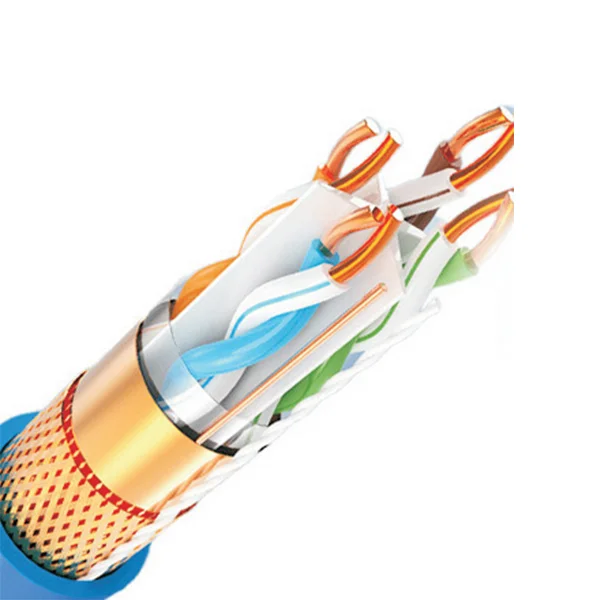
CAT6A S/FTP Cables in the Retail Industry
In the retail sector, high-speed data transmission underpins operations such as POS (point-of-sale) systems, inventory management, and security monitoring.
CAT6A S/FTP network cables are widely used to connect cash registers, database servers, and monitoring systems in supermarkets, shopping malls, and chain stores.
The superior shielding ensures that even in environments crowded with electronic equipment—such as barcode scanners, displays, and wireless routers—signal interference remains minimal, maintaining operational efficiency and data accuracy.
CAT6A S/FTP Network Cable in Medical Facilities
Modern hospitals and medical centers depend on stable data networks to support advanced medical imaging systems, patient monitoring devices, and information management systems.
CAT6A S/FTP cables offer low latency and interference-free connectivity, which is critical for real-time medical data transfer.
Whether transmitting high-definition diagnostic images or connecting monitoring systems in intensive care units, the cable’s shielding design ensures data security and stability, supporting the seamless functioning of critical healthcare operations.
CAT6A S/FTP Cabling in Educational Institutions
The education sector increasingly relies on high-speed networks for digital classrooms, smart libraries, and online learning platforms. Schools and universities often deploy CAT6A S/FTP network cables in classrooms, laboratories, and research centers to connect projectors, interactive boards, and computer terminals.
With high transmission bandwidth and low interference, CAT6A cabling provides a reliable backbone for e-learning and data-intensive applications, ensuring that teachers and students experience smooth connectivity for both academic and administrative systems.
Application of CAT6A S/FTP Network Cables in Transportation Systems
In transportation facilities such as subways, high-speed railways, and airports, data transmission reliability is critical to operational safety.
CAT6A S/FTP cables connect control systems, monitoring cameras, and passenger information displays, enabling real-time data exchange for efficient coordination.
The durable PE-sheathed variants are particularly suited for outdoor or semi-industrial installations, offering resistance to moisture, abrasion, and temperature fluctuations. Their robust shielding ensures uninterrupted communication even near high-voltage equipment or moving trains.
Supporting Security and Monitoring Systems
Public areas such as parks, streets, stations, and conference halls require continuous surveillance and emergency communication systems.
CAT6A S/FTP network cables connect security cameras, alarm systems, and monitoring servers, ensuring stable video transmission and quick data response.
Thanks to its excellent shielding performance, the cable maintains signal clarity over long distances, supporting 4K or even 8K video monitoring without lag or distortion—crucial for real-time security and public safety management.
Comparing CAT6A S/FTP with Other Network Cable Categories
While lower-category cables like CAT5e and CAT6 are suitable for standard gigabit networks, CAT6A S/FTP cables excel in environments where 10 Gigabit Ethernet performance and electromagnetic protection are essential.
-
CAT5e: Supports up to 1Gbps; minimal shielding.
-
CAT6: Handles up to 10Gbps but only up to 55 meters under ideal conditions.
-
CAT6A S/FTP: Maintains 10Gbps speeds up to 100 meters with robust EMI protection, making it ideal for data centers, hospitals, and transportation hubs.
This combination of high data rate, extended reach, and advanced shielding makes CAT6A S/FTP cables the preferred choice for modern high-performance networks.
Compliance and Quality Assurance
Every CAT6A S/FTP cable is designed in compliance with YD/T 1019-2013, a national telecommunications standard ensuring high reliability and safety in structured cabling systems.
This standardization guarantees consistent electrical performance, durability, and compatibility with global network equipment and protocols.
Manufacturers also perform rigorous testing, including impedance, insertion loss, and return loss checks, to confirm that each batch of cable meets or exceeds performance specifications.
Conclusion
The CAT6A S/FTP network cable embodies the future of high-speed and interference-free communication.
With oxygen-free copper conductors, multi-layer shielding, and 1–500MHz transmission performance, it supports 10Gbps data rates across diverse industries—from retail and healthcare to education, transportation, and security infrastructure.
Built to meet stringent YD/T 1019-2013 standards, this cable ensures reliable, efficient, and future-ready network connectivity. Whether in mission-critical medical systems or large-scale commercial networks, CAT6A S/FTP cables deliver the speed, stability, and safety modern communication demands.
www.dlelectronic.com
Dingliang
Reliable High-Speed Connectivity with CAT6A S/FTP Network Cable最先出现在Dynamics Blog。
]]>